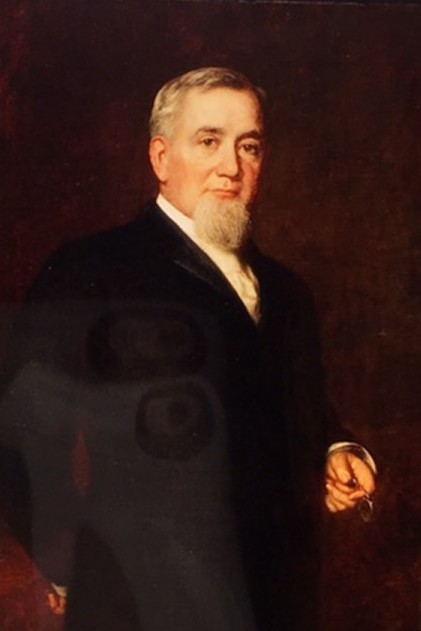
By Megan McKinney

Hotel Florence.
The belief that human beings are deeply influenced by their environment was central to George Pullman’s personal philosophy. It formed the exaggerated grandeur of his rail cars and it would lead him to build the town of Pullman, Illinois. Because he steadfastly believed that individuals who were comfortably housed and surrounded by culture and beauty would be productive workers, he built an idyllic model town for his employees. The site was 3,000 acres on the banks of Lake Calumet and across the lake from his Pullman Palace Car Company plant.

A row of Utopian red brick houses for workers.
Pullman’s company town, designed by New York architect Solon S. Beman and completed in 1881, was a 45-minute train ride south of downtown Chicago. It featured leafy, elm-lined streets, a landscaped park and a lake with a waterfall. There was a church, a train station and a luxury hotel named for Pullman’s beloved daughter Florence. Workers’ houses, all equipped with gas, running water and indoor toilets, were built around an arcade building that contained shops, a library, a post office, savings bank and an 800-seat theater that presented musical and theatrical productions. The aesthetically pleasing buildings were constructed with red bricks made of clay from the bottom of Lake Calumet and baked in the town’s own kiln.

Remove the red automobile and it is 1881.
Pullman’s motives were pragmatic and, on the surface, altruistic, but the rents he charged his workers were more than those for similar housing in Chicago and he made a profit on gas and water he supplied to their houses. In fact, everything he had decided to provide for his employee/ tenants—including the use of the library—had a price, and all charges were docked directly from their paychecks. There was very little money left for workers to buy food for their families. Once more, Pullman was in control, but this time it was tight control of human lives. This loss of freedom and autonomy was merely the beginning. Then came a stock market crash and the Panic of 1893—the harshest of the 19th century—which hit all industries.

The “public” library for which there was an annual fee deducted from salaries.
The nationwide recession severely impacted travel and caused railroads to cut back on the cars they leased from Pullman. Production at the Palace Car Company was reduced, and, although he continued to pay dividends to stockholders, some workers were laid off and others found their hours and wages decreased by as much as 30%. But Pullman would not cut their rents or other charges, and he repeatedly refused to meet with committees organized by his employees who became increasingly incensed.
Families had only pennies a week after deductions were made from their paychecks, and it was believed that some were literally starving.

Pullman Palace Car Company factory.
On May 11, 1894, Pullman workers voted to strike, and 3,000 men threw down their tools and walked off their jobs. In less than two months, 125,000 other railroad workers had joined a sympathy boycott that disrupted mail service and crippled railroad traffic nationwide, without violence. But when President Grover Cleveland sent in federal troops to keep the mail moving, the rioting and carnage began, with mobs of vandals setting fires to hundreds of railway cars. Because the mob carried away many of its wounded and dying, it is unknown how many casualties there were, but at least 34 men died.

Pullman workers. But, look, they are all wearing proper hats. Not a cap-on-backwards in the lot.
Although the boycott and the strike were broken, both George Pullman’s company and his reputation were severely damaged. In addition, in 1896, the Illinois Supreme Court ordered the Pullman Company to divest itself of all residential property. Pullman’s friend, Marshall Field, who had been significant in establishing the Pullman Palace Car Company in the 1860s and was one of its principal stockholders, again came to his friend’s aid in the perilous 1890s. According to late Chicago Sun-Times financial columnist Edwin Darby, when Pullman “let his great car-building company slide to the brink of bankruptcy in the years following the Pullman factory strike…it was Field who stepped in. In what seemed a matter of days and with a few miraculously simple decisions, Field had the company back on its feet.”
Pullman’s health had been seriously undermined by the strike and its aftermath. When, only three years later, he died of heart failure, his funeral was held in the Prairie Avenue mansion in the late afternoon.

It was dark by the time the funeral cortege crept up to Graceland Cemetery, where Pullman’s body, within a lead-lined mahogany casket, was buried in a tomb with 18-inch thick walls. As an extra precaution, several tons of cement were then poured over the vault. Arrogant and controlling to the end, George Pullman left an estate worth $17 million, but bequeathed a mere $3,000 a year to each of his twin sons.

Next in Megan McKinney’s Classic Chicago Dynasties, The Pullman Heirs.
Author Photo:
Robert F. Carl







